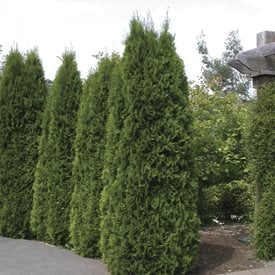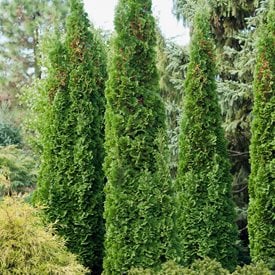Arborvitae - Grow & Care for Arborvitae Trees
Arborvitaes come in a diverse array of shapes and sizes. Here are some varieties to try, along with basic care and planting tips.If you’re looking for fast-growing, easy-care evergreen trees to use as a privacy screen or hedge, arborvitaes are hard to beat. Plant several of them in a row, and in just a year or two the lush, dense foliage will fill in to create the ideal living fence. But don’t overlook the many other ways you can use arborvitaes in both formal and informal garden designs. These versatile conifers are suitable for almost any purpose.
On this page: Basics | Types | Planting | Care | Pruning | Design Ideas | Arborvitae Varieties
- Basics
- Types of Arborvitae
- Planting Arborvitae
- Arborvitae Care
- Pruning Arborvitae
- Design Ideas
- Arborvitae Varieties
ARBORVITAE BASICS
Zones:
Varieties ranging from Zones 2 to 8
Mature height/spread:
The mature size of an arborvitae depends on the species and cultivar. Some low-growing shrubs are under 3 feet tall. Large trees can exceed heights of 70 feet and widths of 25 feet.
Shapes:
Mounded, conical, pyramidal, rounded, or pendulous, depending on the cultivar.
Foliage:
Most arborvitaes have flattened, lacy aromatic needles, ranging from emerald green to gold. Clusters of rosebud-shaped cones measuring about ½ inch long appear in early summer, turning from green to nutmeg-brown.
Growth rate:
Growth rate varies depending on the species and cultivar. Some are very fast growers adding 3 to 4 feet per year, while others, such as dwarfs and miniatures, grow much slower.
TYPES OF ARBORVITAE
Arborvitae (Thuja) is a genus of five species, but these two North American natives are the most common:
- American arborvitae (Thuja occidentalis, also called eastern arborvitae): A mainstay of residential gardens because it’s widely available and has loads of cultivars to choose from. Prefers moist but well-drained soil and is very tolerant of cold climates. The foliage tends to darken to bronze in the winter, but some cultivars remain green all year.
- Giant arborvitae (Thuja plicata, also called western red cedar): Native to the Pacific Northwest, this fast-growing thuja can reach heights of 70 feet or more, although smaller cultivars are available if you prefer a shrub-sized plant. It grows best in coastal climates (Zones 5-7) with cool summers and mild, wet winters but is adaptable to most soil conditions. It has a uniformly conical shape, spreading up to 20 feet at the base. The foliage has the added advantage of remaining green all year.
- Other plants are commonly called arborvitae as well, they include: Chamaecyparis, Thujopsis, and Platycladus.
HOW TO PLANT ARBORVITAE
When to plant:
You can plant an arborvitae at any time of year, but fall is typically the best season because the cooler temperatures prevent heat stress and the moisture from fall rains helps to establish a strong, healthy root system. (See What to Plant in Your Fall Garden)
Where to plant:
- Plant your arborvitae in a spot that receives at least 6 hours of full sun daily. Although some varieties can tolerate partial shade, growth will become sparse if they don’t receive enough light.
- Arborvitaes grow in most soil types, but they don’t like soggy feet. Plant only in well-drained soil, or add amendments to improve drainage if your soil contains a lot of sand or clay. (See Garden Soil 101.)
- Plant arborvitaes where they can spread their roots and have room to grow to their mature size.
Plant spacing:
When planting a hedge or screen, leave at least 3 to 4 feet between plants. Staggering arborvitaes in a zig-zag pattern instead of cramming them into a tight row will look more natural and give them more space.
How to plant:
- When purchasing a potted or burlap-wrapped arborvitae at a nursery, plan on planting it in your garden within a few days after bringing it home so the roots don’t dry out.
- Dig a planting hole that is an inch less deep than the plant's root ball but two to three times as wide so the roots have room to expand.
- Place your arborvitae in the hole, making sure that the top of the root ball is higher than the surface of the soil so the roots don’t suffocate. Gently fill the hole with excavated soil, and water thoroughly to settle the soil. Do not pack the soil or tamp with feet.
- After planting, water the roots thoroughly by letting a hose drip at the plant base or use a soaker hose. Repeat these deep soakings at least twice a week (if you don't receive rain) until the roots become established.
Planting in containers:
Smaller cultivars of arborvitae can be used as attractive container plants or topiaries that will provide season-long interest. Dwarf forms, in particular, are tolerant of some root restriction and can thrive outdoors in pots for years.
- Choose a suitable pot size (one a few inches larger than the size of the root ball) to give the roots ample growing room. Your pot can be made of clay, ceramic, concrete, fiberglass, treated wood, or sturdy plastic. In colder climates, use a material that is freeze-thaw resistant. Good drainage is a must.
- Partially fill the pot with a high-quality potting mix, preferably one specifically formulated for evergreens. Don’t use garden soil, which is too heavy and compact and will inhibit drainage.
- Place the root ball on top of the soil in the middle of the pot, and then add more soil until it reaches the top of the root ball. After planting, water the soil thoroughly and then lightly tap the surface to remove any air pockets.
- To help retain moisture, spread a layer of mulch or compost over the top of the container around the root ball.
ARBORVITAE CARE

Mulching around the base of your arborvitaes will help retain moisture in the soil. Photo by: Ozgur Coskun / Shutterstock.
Fertilization:
When planted in good soil and given enough water and sunlight, an arborvitae rarely needs fertilizer. However, if new growth becomes sparse or your soil is less than ideal, you may need to give your plant a nutritional boost. (See these recommendations for fertilizing evergreens from the University of Minnesota Extension.)
For arborvitaes in containers, fertilize regularly to replace nutrients that leach out of the soil. Use a slow-release granular fertilizer to avoid root burn, and water well before and after each application.
Watering:
Give newly planted shrubs about an inch of water a week during the growing season. Keep the soil evenly moist but not saturated. Decrease the frequency of watering as the roots become established. Use a hose to deliver water directly to the root zone.
Potted arborvitaes should be watered regularly, even during the winter months. Because evergreens don't go completely dormant in winter, they will still need moisture.
Arborvitaes can suffer stress from both underwatering and overwatering. If your plant isn’t getting enough water, the foliage will start to yellow or brown and the needles may drop. (In fall, some browning and needle drop is normal.) Overwatering may also cause needle discoloration and could lead to irreversible damage caused by root rot and fungal infection.
Winter care:
Heavy snow and ice buildup can bend and break the branches of taller arborvitaes. Use a broom to gently brush off heavy, wet snow before it has a chance to accumulate.
Some types of arborvitae, especially those that put out two or more leaders, may need to be staked to keep them upright. Storm-damaged arborvitaes can often be rejuvenated by pulling the drooping branches upright with ties and pruning off broken limbs. See these winter care tips from the University of Illinois Extension.
Diseases and pests:
One reason why arborvitaes are so popular is because they are rarely troubled by insect and disease problems. However, they may succumb to needle and twig blight caused by fungal attack, especially if air circulation is inhibited by crowding plants too closely together. To control blight, prune off all affected branches and treat with a fungicide.
Also watch out for bagworms, which like to feed on the foliage of arborvitaes and other evergreens. Spider mites and stem canker can also be problems.
Are arborvitae deer resistant?
The soft needles of American arborvitae are a delicacy for foraging deer— and unfortunately, won’t grow back. If deer are a problem in your garden, try giant arborvitae like Spring Grove® or a juniper. (See more deer-resistant plants.)
ARBORVITAE PRUNING
Arborvitaes will retain their natural shape as they mature, and regular pruning usually isn't necessary. They will tolerate more frequent and heavier pruning if shaped into formal hedges and topiaries. Follow these tips for best results:
- Give arborvitaes a light pruning in early spring to keep them tidy and encourage thicker growth.
- New growth only develops from the leafy part of a branch, don’t cut back to bare wood.
- Maintain the natural shape of your arborvitae—wider at the bottom than the top. If you prune it into a V shape, the lower branches will be shaded and the foliage may die back or become sparse.
- Remove dead or diseased branches at the point where they leave the trunk. This will prevent decay and allow new growth to fill in the gaps.
- Remove accumulated dead foliage inside the plant annually or more frequently to improve air circulation and reduce chance of disease.
- Use selective pruning or thinning cuts to lower the height—don’t lop off the top of an arborvitae. No new growth will occur once the branch tips have been cut, and you’ll end up with a permanent buzz cut.
Here are some additional tips from The Morton Arboretum on the best methods for pruning arborvitaes and other evergreens.
USING ARBORVITAE IN THE GARDEN
Here are some design ideas for incorporating arborvitaes into your garden:
- Add instant sophistication to an entryway by placing a matching pair of arborvitaes on either side of your front door.
- Create evergreen focal points in the garden by intermixing arborvitaes with your perennials.
- Use larger arborvitaes as statuesque specimen trees, or plant smaller cultivars in decorative pots and sculpt them into eye-catching topiaries.
ARBORVITAE VARIETIES
RELATED:
Best Evergreen Trees for Residential Gardens
15 Best Shrubs for Privacy
Conifer Guide
Trees for Privacy
Evergreen Shrubs
















